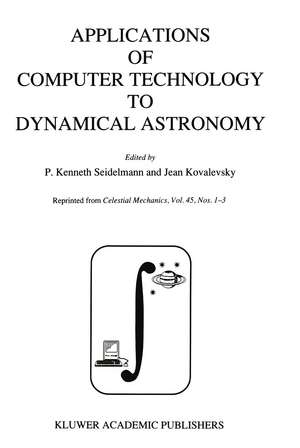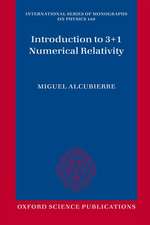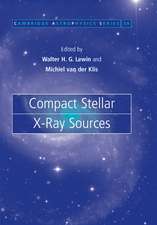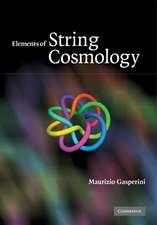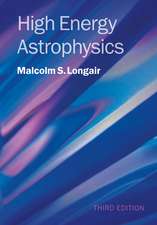Applications of Computer Technology to Dynamical Astronomy: Proceedings of the 109th Colloquium of the International Astronomical Union, held in Gaithersburg, Maryland, 27–29 July 1988
Editat de P. Kenneth Seidelmann, Jean Kovalevskyen Limba Engleză Paperback – 22 ian 2012
Preț: 643.16 lei
Preț vechi: 756.65 lei
-15% Nou
Puncte Express: 965
Preț estimativ în valută:
123.07€ • 131.60$ • 102.61£
123.07€ • 131.60$ • 102.61£
Carte tipărită la comandă
Livrare economică 18 aprilie-02 mai
Preluare comenzi: 021 569.72.76
Specificații
ISBN-13: 9789401069328
ISBN-10: 9401069328
Pagini: 352
Ilustrații: X, 341 p.
Dimensiuni: 160 x 240 x 18 mm
Greutate: 0.49 kg
Ediția:Softcover reprint of the original 1st ed. 1989
Editura: SPRINGER NETHERLANDS
Colecția Springer
Locul publicării:Dordrecht, Netherlands
ISBN-10: 9401069328
Pagini: 352
Ilustrații: X, 341 p.
Dimensiuni: 160 x 240 x 18 mm
Greutate: 0.49 kg
Ediția:Softcover reprint of the original 1st ed. 1989
Editura: SPRINGER NETHERLANDS
Colecția Springer
Locul publicării:Dordrecht, Netherlands
Public țintă
ResearchCuprins
1/Applications of Computers to Solving Problems.- Early Applications of Computer Technology to Dynamical Astronomy.- Applications of Computers to Celestial Mechanics.- Applications to Stellar and Galactic Dynamics.- Application of Computer in Qualitative Studies of Celestial Mechanics.- Leading Spiral Arms, Retrograde Galaxy Encounters and Massive Halos.- On Construction of Analytic Solutions to the Three Body Problem by Use of Computer Experiments.- The Use of Computer Algorithms in the Construction of a Theory of the Long-Period Perturbations of Saturn’s Satellite Hyperion.- Some Numerical Aspects in a Search for I=1 Periodic Orbits for Hecuba Asteroids.- SHORDE I Program System and Applications.- A Semi-numerical Expansion of the Averaged Disturbing Function for Some Very-high-eccentricity Orbits.- Symbolic Algebra Software for Planetary Theories.- Tests of the Extrapolation Method for the Numerical Integration of the Keplerian Motion.- Application of a Massively Parallel Computer to the N-body Problem.- Hydrodynamical Models of Elliptical Galaxies.- A Multifluid Code for Problems of Elliptical Galaxy Formation and Evolution.- 3D Hydrodynamics and Radiative Transfer.- First-order and Second-order 3-D Hydrodynamics: A Comparison.- Chaotic Dynamics and Monte Carlo Modelling.- Software Tools for Nonlinear Dynamics.- Computer Algebra, Lie Transforms and the Nonlinear Stability of L4.- Solution of an Infinite Number of Inequations Depending on a Continuous Parameter and Application to the Solution of Equations in Dynamical Astronomy.- 2/Matching Problems with Technology.- Planet Crossing Asteroids and Parallel Computing: Project Spaceguard.- Implementation of an N-body Code in a HP1000 Computer.- Computer Applications to Lunar and Artificial Satellite Laser Ranging.-The Use of Image Processors for Acquisition and Reduction of Astrometric Data in Real Time.- Modeling of Asymmetric Light Curves of Eclipsing Binaries on the Cyber 205 Supercomputer.- Galaxies in the Connection Machine.- 3/New Methods of Mathematical Programming.- Specialized Celestial Mechanics Systems for Symbolic Manipulation.- On a Restricted (2n+3)-Body Problem.- The Simplex Method for Nonlinear Mass Determinations.- An Optimum Method for Calculating Restricted Three-Body Orbits.- The Constrained Normal Form Algorithm.- 4/Matching Computer Language to the Problem.- Simplify or Perish.- The Stability of the Lagrangian Point L4.- Computer Implementation of a New Approach to the Ideal Resonance Problem.- A Laboratory for Gravitational Scattering Experiments.- Problem Oriented Language for Ephemeris Astronomy and its Realisation in the System ERA.- 5/Use of Numerical Versus Algebraic Computation.- Numerical Integration Methods in Dynamical Astronomy.- A Survey of Poisson Series Processors.- A FORTRAN-based Poisson Series Processor and its Applications in Celestial Mechanics.- PARSEC: An Interactive Poisson Series Processor for Personal Computing Systems.- The Problem of the Eulerian Oscillations: A Weakness of Numerical Versus Analytical Methods.- A Semi-Analytical Method to Study Perturbed Rotational Motion.- Computational Studies of Cloudy Gaseous Galactic Disks.- 6/Representation and Transmission of Results.- Synthetic Secular Theories of the Planetary Orbits: Regular and Chaotic Behaviour.- Numerical Representation of Planetary Ephemerides.- Compressed Planetary and Lunar Ephemerides.- An Analytical Representation of Ephemeris Data.- Numerical Simulations of Narrow Planetary Rings: An Animation.- Electronic Almanacs Mating the Message and the Medium.- List of Participants.- Errata.
